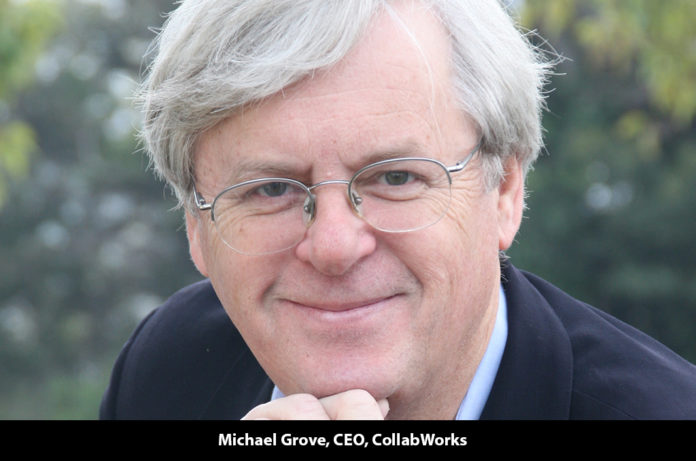
Harnessing the Power of People
To read the original PDF article, click here.
In today’s world, people and technology are inseparable. A key to every company’s financial success is building an agile, engaged workforce that uses technology to both identify the most valuable work performed by every employee and optimize this valuable work’s execution. A digital workforce culture drives innovation, improves decision-making, and increases value. Estimates suggest that companies typically experience 20% to 50% in wasted work and talent misuse or under-utilize talent because they do not have the necessary data to match the work to the talent.
Since its inception in 2014, Redwood City, CA-based CollabWorks has abided by the motto, “if you can measure value you can improve it” The company provides SaaS solutions that simplify management, shifts employees from low-value work to high-value work and helps improve margins – representing the holy grail of management science. At its core is the technology ‘simplifies managing so you capture your full potential’ as individual and organization.
“The improvement in profitability will create a tsunami of adoption. It will reshape how corporations manage and empower individuals to thrive”,
says Michael Grove, CollabWorks Founder, and Digital Management Systems.
The fundamentals of managing are not rocket science. Aligning talent to work, setting objectives and priorities, focusing on value creation, and better serving customers are examples of best practices provided by the CollabWorks management framework. The company is being recognized as an early leader of a new class of software applications:
” I aspire to shift the way people are managed such that they are motivated and encouraged to reach their full potential. Second, to create a new organizational model that scales rapidly yet remains lean and highly adaptable.”
says Michael
A Trailblazer
Michael Grove is a serial entrepreneur who has been a chief executive officer for 25 years. An expert in blending on-demand workers with employee talent, he gets to the heart of the organization and successfully drives them for excellence. Michael’s earlier funded ventures include: Open Country, a leader of remote systems management; Introplus, a social matching-engine company; and MicroModule Systems, a semiconductor packaging company. Prior to founding these companies, Michael was a Director of New Ventures at Lockheed-Martin. His distinctive entrepreneurial qualities won him a leveraged buy-out of a $400M technology and semiconductor fab. Since the buyout, the firm scaled from zero to the number one multi-chip module supplier. He has deep functional experience in sales, marketing, engineering, and program management in a broad range of businesses including – aerospace, renewable energy, M&A, semiconductor, systems management, social networking, and productivity tools. He has published numerous papers, received several patents, and coached a variety of startup companies.
A risk-taker, Michael has always believed in taking the road less traveled. He has spent much of his career navigating major risk challenges and finding a positive path forward. In the ‘quiet period’ with three well-known investment banks, he watched the IPO window close as the economy weakened, and the IPO market closed. While disappointed he observed.
“Life is not about how many badges you wear or what people think of you. It is about recognizing that at any instant we can choose between what matters and what matters not. Thus, we are always free to enjoy our experiences and love those we care about”
Says Michael
He enjoys working on huge challenges with big payoffs rather than play it safe. He has experienced no bigger opportunity than his current venture.
The CollabWorks team is of deeply experienced and successful entrepreneurs who are transparent, supportive, and passionate about achieving their collective vision.
Michael also leads a thought leadership community, envisioning the future of work called Disrupt. Work, which is committed to improving work, worker, and the workplace. Michael relaxation ritual involves his hobbies i.e. gardening, fixing, and cooking good food. He enjoys watching stimulating drama that helps him unwind the end of the day.
CollabWorks: DNA of Change
CollabWorks began its journey in creating the FrameWork™ by working with the University of California at Berkeley and together interviewing 26 corporations from Autodesk to Facebook. The research demonstrated the need to improve the visibility and measurement of the most important components of any business – the work, its value, and the talent required to get it done. Additionally, improved work efficiency also requires a comfortable and user-friendly work environment, which can be achieved by providing quality interiors, comfortable furniture (check out office monster or similar office supply sellers for more information), and other resources to relax and rejuvinate. Thereby, enabling organizations to improve productivity through worker engagement, talent-initiated improvements, management decision-making, and talent alignment.
FrameWork™ combines a unique methodology with easy-to-use technology to drive measurable and sustained improvement in productivity across the organization. It is a data-driven, solution that improves the bottom line by aligning the right work to the right worker at the right time. With FrameWork, HR leaders and their business partners have the ideal platform for quantifiably evaluating talent, allocating work, and improving margin creation among all levels of the organization Moreover, FrameWork provides workers with an agile, transparent, data-driven approach that empowers each worker to perform meaningful work and make improvements that benefit their career, their team, and their entire organization. FrameWork works in three steps:
- Share (a quick anonymous assessment of participants perceptions of their work/talent),
- Discover (service data for the entire group is generated in real time),
- Transform (performance metrics enable optimization of transformation plans).
FrameWork thus provides the essential data and technology to drive a measurable increase in the value of both work and talent. It is proven to lower operational costs, inspire innovation, and deliver measurable and continuous increases in productivity. FrameWork customers, who implemented full-scale deployment, have achieved an improvement of 10% operating profit or more.
The company aims to shift from a semi-stealth mode to formally launching in Q1 2019.




Recent Comments